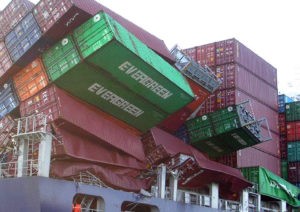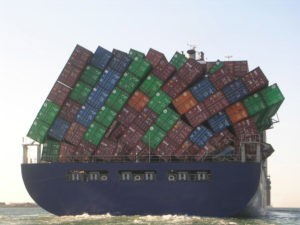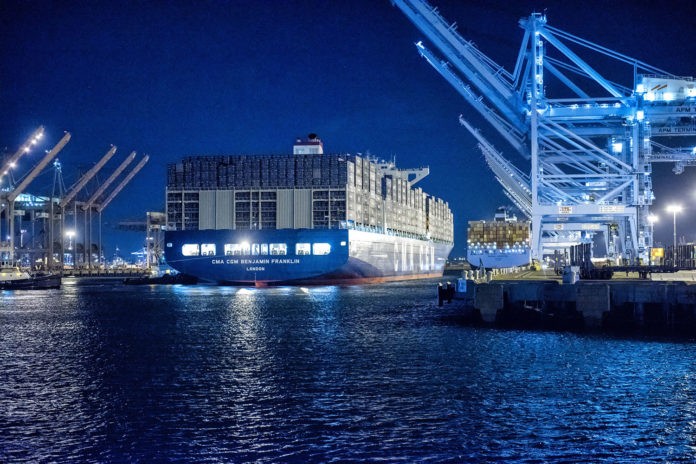In September 2009 the Dutch ship model testing basin, Marin, published a comprehensive report called Lashing@Sea, detailing the issues with container lashing as a precursor to regulatory improvements that would make the industry safer, most agree that little has changed since that time.
More than 10 years on from the Marin report the only regulatory change that has been achieved has been the introduction of verified gross mass (VGM) regulations which is clearly an important step, which we will discuss in the May issue of the Container News Cargo Integrity Campaign.
Regulation on the container lashing is considered ineffective, however, with the former container shipping expert at classification society Lloyd’s Register (LR) explaining that the regulations “have no teeth,” and that “Shipowners and flag states simply hold up their hands and say what can we do?”

The International Maritime Organization (IMO) has published a voluntary guide to lashing, MSC.1/Circ.1352/Rev.1, in December 2015, but the document is an “invitation” to member states to bring the circular to the attention of shipowners and maritime professionals. And this year’s Maritime Safety Committee meeting was due to discuss the issue before it was postponed due to the Covid-19 outbreak.
Retired LR expert David Tozer’s view, which he had raised as an issue of safety as long ago as 2008, when DP World had highlighted the high incidence of accidents as a consequence of a lack of safety equipment and design, including simple rails to prevent falls, still holds true the authorities have no enforceable regulation.
Another industry expert, who preferred to remain anonymous, told Container News, that the fact the Marin report was published more than 10 years ago and that little has changed since, “Undermines the industry’s claim that it is doing everything it can to prevent cargo losses.”
Peregrine Storrs-Fox, risk management director at the TT Club, said that the Marin report was comprehensive, but “there has been no follow-up to it and there are outstanding issues that they raised”.
Marin concluded in 2009, “There is a perception that container transport is troubled by unacceptably large losses. This was found to be hard to determine as no centralised databases are kept with regards to losses and details on incidents are typically unavailable.”
According to Storrs-Fox insurance companies will mainly be involved in larger casualties, that was true in 2009 and it remains true today. And it was the lack of information that prompted Marin to say, “Because of this there is also no means to evaluate for systematic trends in incidents or returning triggers for incidents. It was however clear that the unexplained losses of entire bays in recent years need to be explained. “
The Marin report argues that the regulations do not consider the deformation of the hull as the vessel travelled through the water, introducing heavier than expected impacts and loads on container stacks.

“Dynamic tests with multiple rows indicated that extreme loads are not expected when securing arrangement is in agreement with the design and no gaps open up. It was however found that the system is sensitive to off design conditions, Dynamic load amplifications up to a factor 2 to 3 were found in these cases. This indicates the need of compliance between designed and actual stow configuration.”
It is this interaction between stacks which Marin said is “sensitive to off-design conditions,” meant that the forces on the stacks could be amplified by up to three times the design loads.
“Interaction forces are considered to be the most likely reason for progressive collapse of multiple rows when due to a combined occurrence of events one or more stacks become unstable,” concluded Marin.
Another suggested reason for the loss of containers through the collapse of stacks is through the inability of stowage software to recognise the varying sizes of containers. This was a cause for the loss of containers in 2007 on the Annabella which had 30ft Eurotraffic boxes that were not identified by the software package in use, according to Storrs-Fox.
More recently Storrs-Fox cites the losses from the CMA CGM George Washington, which lost 137 containers from a stack failure in January 2018.
The Marine Accident Investigation Branch report into the CMA CGM George Washington said that the reduced structural strength of the non-standard 53ft containers, inaccurate container weight declarations, inappropriately stowed containers and loose lashings led to the loss of cargo.
Amerinder Sing Brar, a former container ship master, now working with London Offshore Consultants, expressed surprise at the idea that stowage software packages could not identify the sizes of containers. He said that most modern packages have bolt-on systems to help with the stowage plans and will recognise the various types and sizes of containers.
Stowage software should recognise the type, size and weight of each container and calculate the stability of the vessel when loaded, provided that all the weights of the loaded containers are correct.
Stability, explained Brar, is a key element to the safe stowage of the cargo because the vessel will pitch and roll when at sea. “In a small vessel the GM [centre of gravity] doesn’t change much, but as the vessel sizes get larger, above around 5,000TEU the movement is greater with the forward part of the vessel experiencing more forces through pitching and the mid-section more susceptible to rolling.”
With the larger vessels the centre of gravity could also change after each port call, said Brar.
The former captain went on to say, “A stack collapses when the container frame experiences forces outside of its design limits, but we know about static forces.”
However, when a ship rolls and pitches then dynamic forces come into play, and then “depending on the location of the stack on the vessel it becomes a Russian Roulette which stack exceeds the force limits.”
In addition, there is a question over whether the forces on the stack have loosened the lashings and twistlocks, which in bad weather cannot easily be checked.
One solution to working in poor conditions and in dangerous areas was put forward by a major terminal operator that wanted to remain anonymous. A spokesperson told Container News, that the answer to the dangers of lashing operations was to automate the process, “in the interest of the industry to automate both activities [lashing and applying twistlocks] for better operational efficiency and worker safety”.
The port operator said that so far automation has been frustrated by the wide variety of different lashing systems and twistlocks.
“While it may be sensible to equip new builds with the same design, the touchy question is: which design from which manufacturer? Moreover, to replace twistlocks on existing ships will be a costly affair and begs the question about who will bear the cost? Another thorny issue is the perception among shipping lines that they bear the cost of such standardisation, but the benefits go to terminal operators,” explained the spokesperson.
However, Brar also pointed out that each ship is different, with plugs and arrangements for cargo stowage varying from ship to ship, automation, he concluded, could only work if the ships themselves were standardised.
This is Part One of the Lashings stories in our Cargo Integrity Campaign. Part Two will be published tomorrow.
Nick Savvides
Managing Editor
Marin lists the commonly known effects that add to stack instability and increase excitation loads:
- Poor deck fittings and twist locks have a bad effect on stack stability. Incidents learn that damages and corrosion can go unnoticed;
- Wrongly applied lashings;
- Lashings often loosen up and need to be re-tightened. This is done in daily routine surveys (Which is not possible when the weather becomes severe);
- The stow sequence and thus vertical weight distribution is often different from the stow plan. Crews mention this occurs regularly depending on port of call. If heavy boxes are stowed higher in the stack, the forces in lower tiers can exceed design limits and stacks may become unstable;
- High transverse accelerations in off design loading conditions (e.g. extreme GM) may raise excessive loads that loosen up/damage securing of highly loaded stacks, poor lashing gear or bottom tier container integrity;
- Crew questionnaire findings showed that it is hard to recognise when loads become too high and decide when and what measures are needed to keep it inside safe working limits.







